Business Environment Report
VerifiedAdded on 2020/01/28
|16
|4514
|464
Report
AI Summary
This report analyzes the business environment of Sainsbury PLC, a major UK retailer. It examines the company's organizational structure (comparing it to Tesco's), the influence of contrasting economic environments (stability vs. recession), and the impact of political, social, legal, and technological factors (using a PESTLE framework). The report also details stakeholder analysis, including the viewpoints and influence of various stakeholders like customers, suppliers, and investors. The analysis highlights challenges faced by Sainsbury's in navigating economic uncertainty and securing financing. The conclusion emphasizes the significant impact of external factors on Sainsbury's sustainability and growth, while acknowledging the company's proactive initiatives to mitigate these challenges.
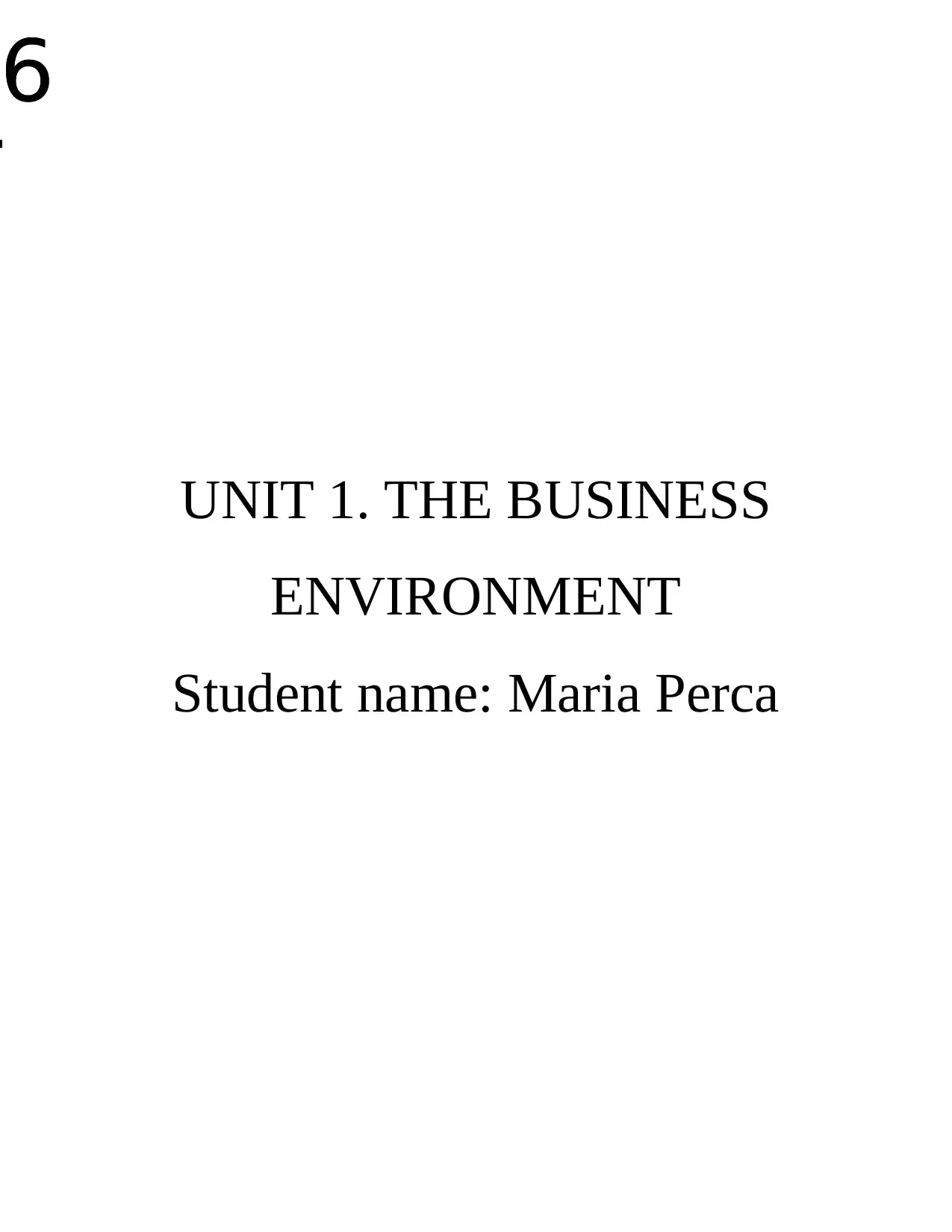
UNIT 1. THE BUSINESS
ENVIRONMENT
Student name: Maria Perca
S
a
i
n
s
b
u
r
y
P
L
6
T
h
e
p
u
r
p
o
s
S
a
i
n
s
b
u
r
y
P
L
6
T
h
e
p
u
r
p
o
s
ENVIRONMENT
Student name: Maria Perca
S
a
i
n
s
b
u
r
y
P
L
6
T
h
e
p
u
r
p
o
s
S
a
i
n
s
b
u
r
y
P
L
6
T
h
e
p
u
r
p
o
s
Paraphrase This Document
Need a fresh take? Get an instant paraphrase of this document with our AI Paraphraser
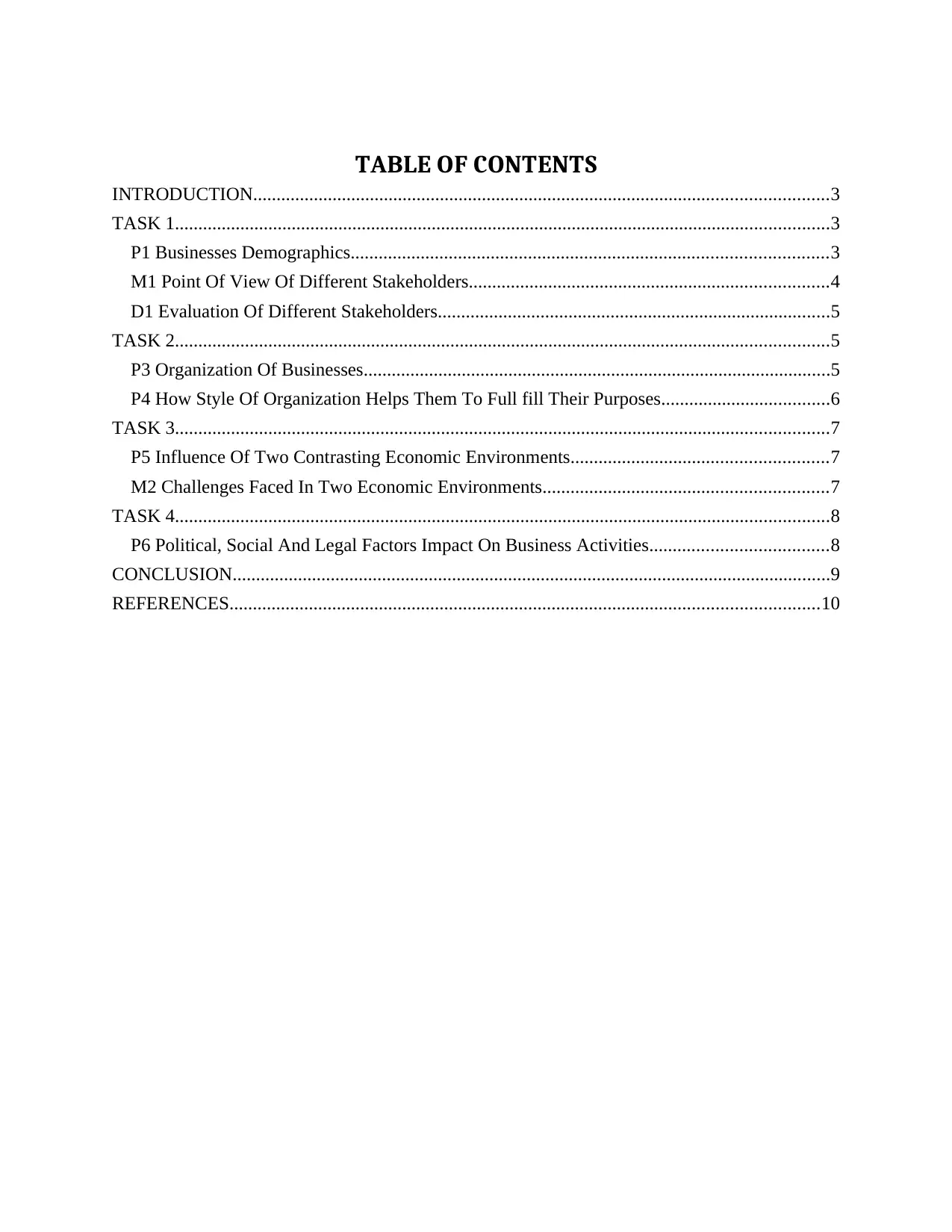
TABLE OF CONTENTS
INTRODUCTION...........................................................................................................................3
TASK 1............................................................................................................................................3
P1 Businesses Demographics......................................................................................................3
M1 Point Of View Of Different Stakeholders.............................................................................4
D1 Evaluation Of Different Stakeholders....................................................................................5
TASK 2............................................................................................................................................5
P3 Organization Of Businesses....................................................................................................5
P4 How Style Of Organization Helps Them To Full fill Their Purposes....................................6
TASK 3............................................................................................................................................7
P5 Influence Of Two Contrasting Economic Environments.......................................................7
M2 Challenges Faced In Two Economic Environments.............................................................7
TASK 4............................................................................................................................................8
P6 Political, Social And Legal Factors Impact On Business Activities......................................8
CONCLUSION................................................................................................................................9
REFERENCES..............................................................................................................................10
INTRODUCTION...........................................................................................................................3
TASK 1............................................................................................................................................3
P1 Businesses Demographics......................................................................................................3
M1 Point Of View Of Different Stakeholders.............................................................................4
D1 Evaluation Of Different Stakeholders....................................................................................5
TASK 2............................................................................................................................................5
P3 Organization Of Businesses....................................................................................................5
P4 How Style Of Organization Helps Them To Full fill Their Purposes....................................6
TASK 3............................................................................................................................................7
P5 Influence Of Two Contrasting Economic Environments.......................................................7
M2 Challenges Faced In Two Economic Environments.............................................................7
TASK 4............................................................................................................................................8
P6 Political, Social And Legal Factors Impact On Business Activities......................................8
CONCLUSION................................................................................................................................9
REFERENCES..............................................................................................................................10
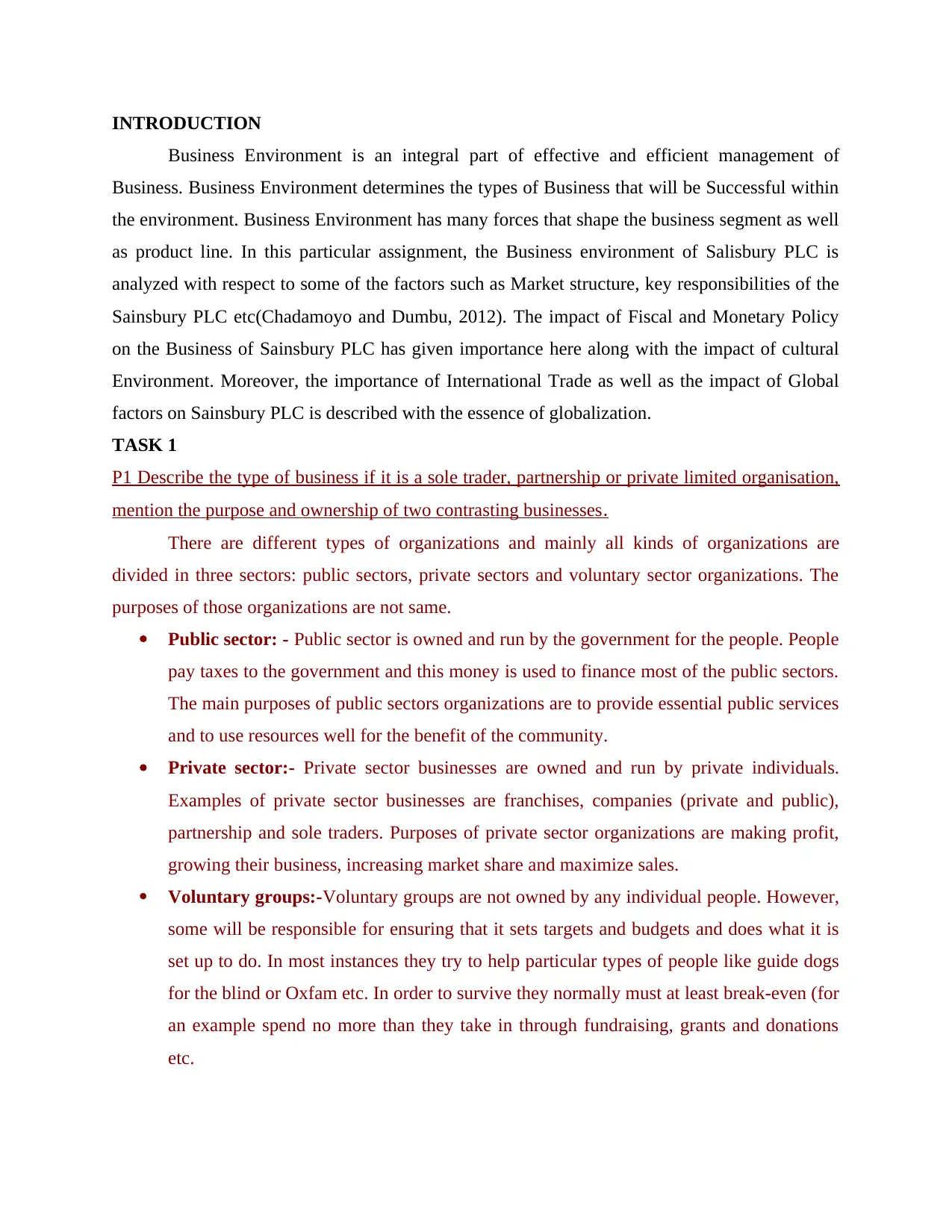
INTRODUCTION
Business Environment is an integral part of effective and efficient management of
Business. Business Environment determines the types of Business that will be Successful within
the environment. Business Environment has many forces that shape the business segment as well
as product line. In this particular assignment, the Business environment of Salisbury PLC is
analyzed with respect to some of the factors such as Market structure, key responsibilities of the
Sainsbury PLC etc(Chadamoyo and Dumbu, 2012). The impact of Fiscal and Monetary Policy
on the Business of Sainsbury PLC has given importance here along with the impact of cultural
Environment. Moreover, the importance of International Trade as well as the impact of Global
factors on Sainsbury PLC is described with the essence of globalization.
TASK 1
P1 Describe the type of business if it is a sole trader, partnership or private limited organisation,
mention the purpose and ownership of two contrasting businesses.
There are different types of organizations and mainly all kinds of organizations are
divided in three sectors: public sectors, private sectors and voluntary sector organizations. The
purposes of those organizations are not same.
Public sector: - Public sector is owned and run by the government for the people. People
pay taxes to the government and this money is used to finance most of the public sectors.
The main purposes of public sectors organizations are to provide essential public services
and to use resources well for the benefit of the community.
Private sector:- Private sector businesses are owned and run by private individuals.
Examples of private sector businesses are franchises, companies (private and public),
partnership and sole traders. Purposes of private sector organizations are making profit,
growing their business, increasing market share and maximize sales.
Voluntary groups:-Voluntary groups are not owned by any individual people. However,
some will be responsible for ensuring that it sets targets and budgets and does what it is
set up to do. In most instances they try to help particular types of people like guide dogs
for the blind or Oxfam etc. In order to survive they normally must at least break-even (for
an example spend no more than they take in through fundraising, grants and donations
etc.
Business Environment is an integral part of effective and efficient management of
Business. Business Environment determines the types of Business that will be Successful within
the environment. Business Environment has many forces that shape the business segment as well
as product line. In this particular assignment, the Business environment of Salisbury PLC is
analyzed with respect to some of the factors such as Market structure, key responsibilities of the
Sainsbury PLC etc(Chadamoyo and Dumbu, 2012). The impact of Fiscal and Monetary Policy
on the Business of Sainsbury PLC has given importance here along with the impact of cultural
Environment. Moreover, the importance of International Trade as well as the impact of Global
factors on Sainsbury PLC is described with the essence of globalization.
TASK 1
P1 Describe the type of business if it is a sole trader, partnership or private limited organisation,
mention the purpose and ownership of two contrasting businesses.
There are different types of organizations and mainly all kinds of organizations are
divided in three sectors: public sectors, private sectors and voluntary sector organizations. The
purposes of those organizations are not same.
Public sector: - Public sector is owned and run by the government for the people. People
pay taxes to the government and this money is used to finance most of the public sectors.
The main purposes of public sectors organizations are to provide essential public services
and to use resources well for the benefit of the community.
Private sector:- Private sector businesses are owned and run by private individuals.
Examples of private sector businesses are franchises, companies (private and public),
partnership and sole traders. Purposes of private sector organizations are making profit,
growing their business, increasing market share and maximize sales.
Voluntary groups:-Voluntary groups are not owned by any individual people. However,
some will be responsible for ensuring that it sets targets and budgets and does what it is
set up to do. In most instances they try to help particular types of people like guide dogs
for the blind or Oxfam etc. In order to survive they normally must at least break-even (for
an example spend no more than they take in through fundraising, grants and donations
etc.
⊘ This is a preview!⊘
Do you want full access?
Subscribe today to unlock all pages.

Trusted by 1+ million students worldwide
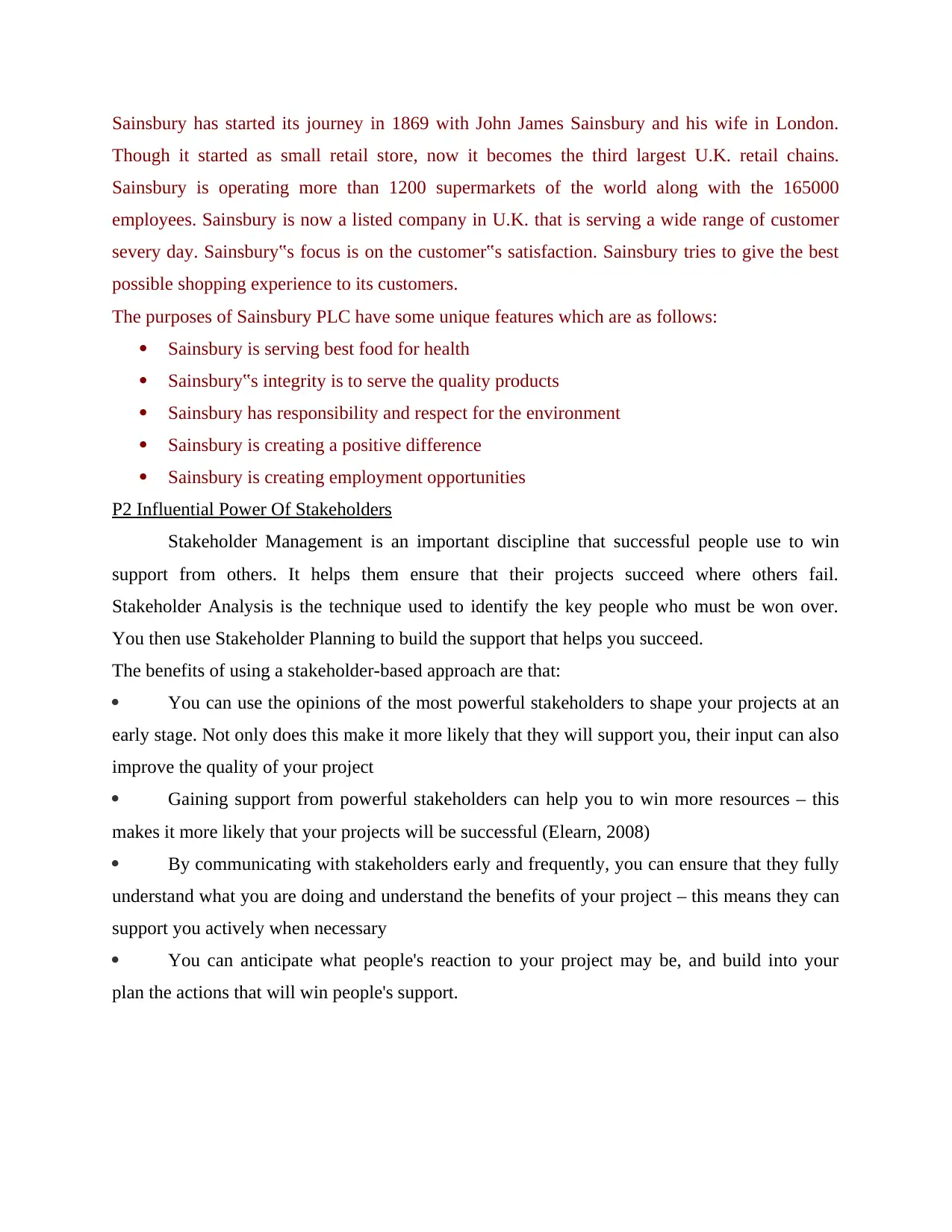
Sainsbury has started its journey in 1869 with John James Sainsbury and his wife in London.
Though it started as small retail store, now it becomes the third largest U.K. retail chains.
Sainsbury is operating more than 1200 supermarkets of the world along with the 165000
employees. Sainsbury is now a listed company in U.K. that is serving a wide range of customer
severy day. Sainsbury‟s focus is on the customer‟s satisfaction. Sainsbury tries to give the best
possible shopping experience to its customers.
The purposes of Sainsbury PLC have some unique features which are as follows:
Sainsbury is serving best food for health
Sainsbury‟s integrity is to serve the quality products
Sainsbury has responsibility and respect for the environment
Sainsbury is creating a positive difference
Sainsbury is creating employment opportunities
P2 Influential Power Of Stakeholders
Stakeholder Management is an important discipline that successful people use to win
support from others. It helps them ensure that their projects succeed where others fail.
Stakeholder Analysis is the technique used to identify the key people who must be won over.
You then use Stakeholder Planning to build the support that helps you succeed.
The benefits of using a stakeholder-based approach are that:
You can use the opinions of the most powerful stakeholders to shape your projects at an
early stage. Not only does this make it more likely that they will support you, their input can also
improve the quality of your project
Gaining support from powerful stakeholders can help you to win more resources – this
makes it more likely that your projects will be successful (Elearn, 2008)
By communicating with stakeholders early and frequently, you can ensure that they fully
understand what you are doing and understand the benefits of your project – this means they can
support you actively when necessary
You can anticipate what people's reaction to your project may be, and build into your
plan the actions that will win people's support.
Though it started as small retail store, now it becomes the third largest U.K. retail chains.
Sainsbury is operating more than 1200 supermarkets of the world along with the 165000
employees. Sainsbury is now a listed company in U.K. that is serving a wide range of customer
severy day. Sainsbury‟s focus is on the customer‟s satisfaction. Sainsbury tries to give the best
possible shopping experience to its customers.
The purposes of Sainsbury PLC have some unique features which are as follows:
Sainsbury is serving best food for health
Sainsbury‟s integrity is to serve the quality products
Sainsbury has responsibility and respect for the environment
Sainsbury is creating a positive difference
Sainsbury is creating employment opportunities
P2 Influential Power Of Stakeholders
Stakeholder Management is an important discipline that successful people use to win
support from others. It helps them ensure that their projects succeed where others fail.
Stakeholder Analysis is the technique used to identify the key people who must be won over.
You then use Stakeholder Planning to build the support that helps you succeed.
The benefits of using a stakeholder-based approach are that:
You can use the opinions of the most powerful stakeholders to shape your projects at an
early stage. Not only does this make it more likely that they will support you, their input can also
improve the quality of your project
Gaining support from powerful stakeholders can help you to win more resources – this
makes it more likely that your projects will be successful (Elearn, 2008)
By communicating with stakeholders early and frequently, you can ensure that they fully
understand what you are doing and understand the benefits of your project – this means they can
support you actively when necessary
You can anticipate what people's reaction to your project may be, and build into your
plan the actions that will win people's support.
Paraphrase This Document
Need a fresh take? Get an instant paraphrase of this document with our AI Paraphraser
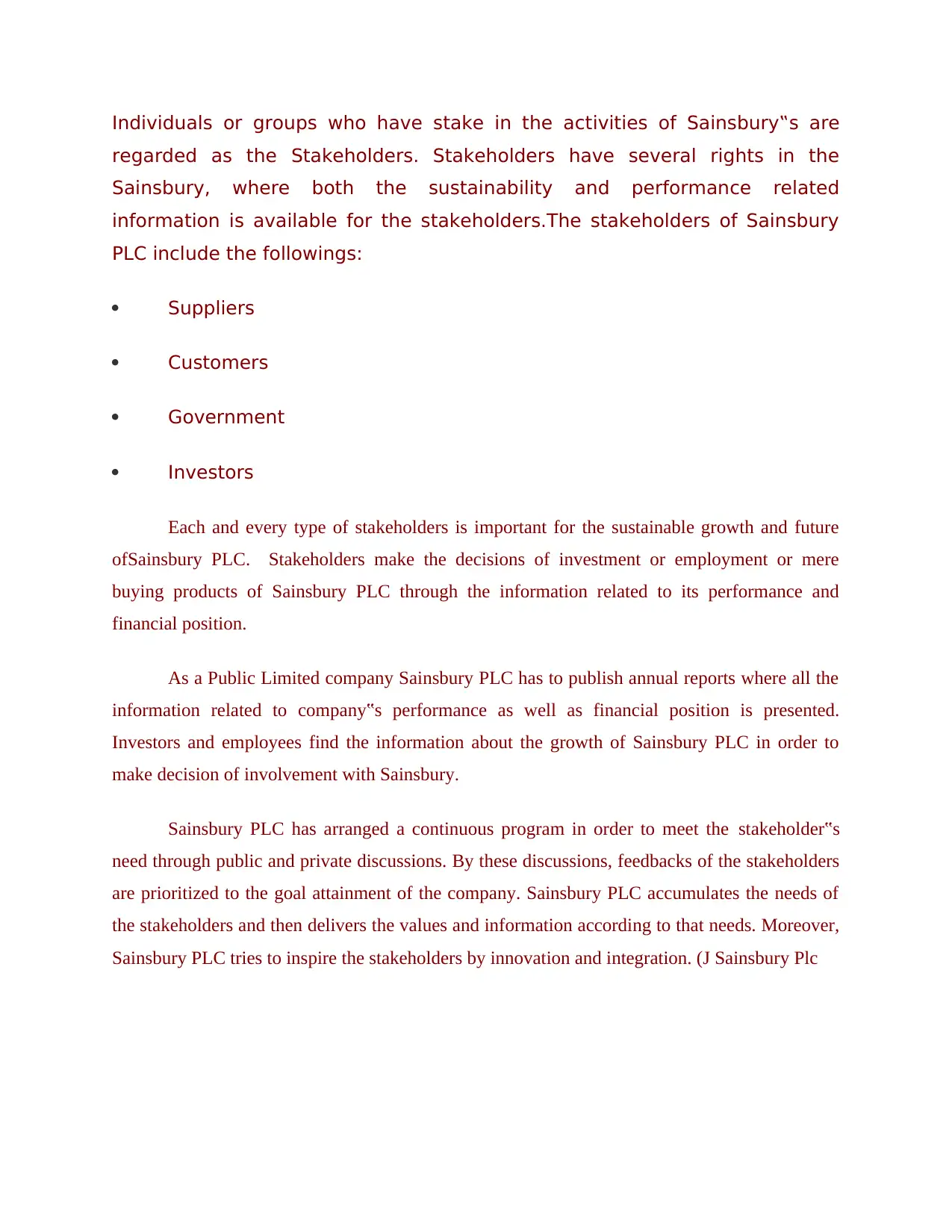
Individuals or groups who have stake in the activities of Sainsbury‟s are
regarded as the Stakeholders. Stakeholders have several rights in the
Sainsbury, where both the sustainability and performance related
information is available for the stakeholders.The stakeholders of Sainsbury
PLC include the followings:
Suppliers
Customers
Government
Investors
Each and every type of stakeholders is important for the sustainable growth and future
ofSainsbury PLC. Stakeholders make the decisions of investment or employment or mere
buying products of Sainsbury PLC through the information related to its performance and
financial position.
As a Public Limited company Sainsbury PLC has to publish annual reports where all the
information related to company‟s performance as well as financial position is presented.
Investors and employees find the information about the growth of Sainsbury PLC in order to
make decision of involvement with Sainsbury.
Sainsbury PLC has arranged a continuous program in order to meet the stakeholder‟s
need through public and private discussions. By these discussions, feedbacks of the stakeholders
are prioritized to the goal attainment of the company. Sainsbury PLC accumulates the needs of
the stakeholders and then delivers the values and information according to that needs. Moreover,
Sainsbury PLC tries to inspire the stakeholders by innovation and integration. (J Sainsbury Plc
regarded as the Stakeholders. Stakeholders have several rights in the
Sainsbury, where both the sustainability and performance related
information is available for the stakeholders.The stakeholders of Sainsbury
PLC include the followings:
Suppliers
Customers
Government
Investors
Each and every type of stakeholders is important for the sustainable growth and future
ofSainsbury PLC. Stakeholders make the decisions of investment or employment or mere
buying products of Sainsbury PLC through the information related to its performance and
financial position.
As a Public Limited company Sainsbury PLC has to publish annual reports where all the
information related to company‟s performance as well as financial position is presented.
Investors and employees find the information about the growth of Sainsbury PLC in order to
make decision of involvement with Sainsbury.
Sainsbury PLC has arranged a continuous program in order to meet the stakeholder‟s
need through public and private discussions. By these discussions, feedbacks of the stakeholders
are prioritized to the goal attainment of the company. Sainsbury PLC accumulates the needs of
the stakeholders and then delivers the values and information according to that needs. Moreover,
Sainsbury PLC tries to inspire the stakeholders by innovation and integration. (J Sainsbury Plc
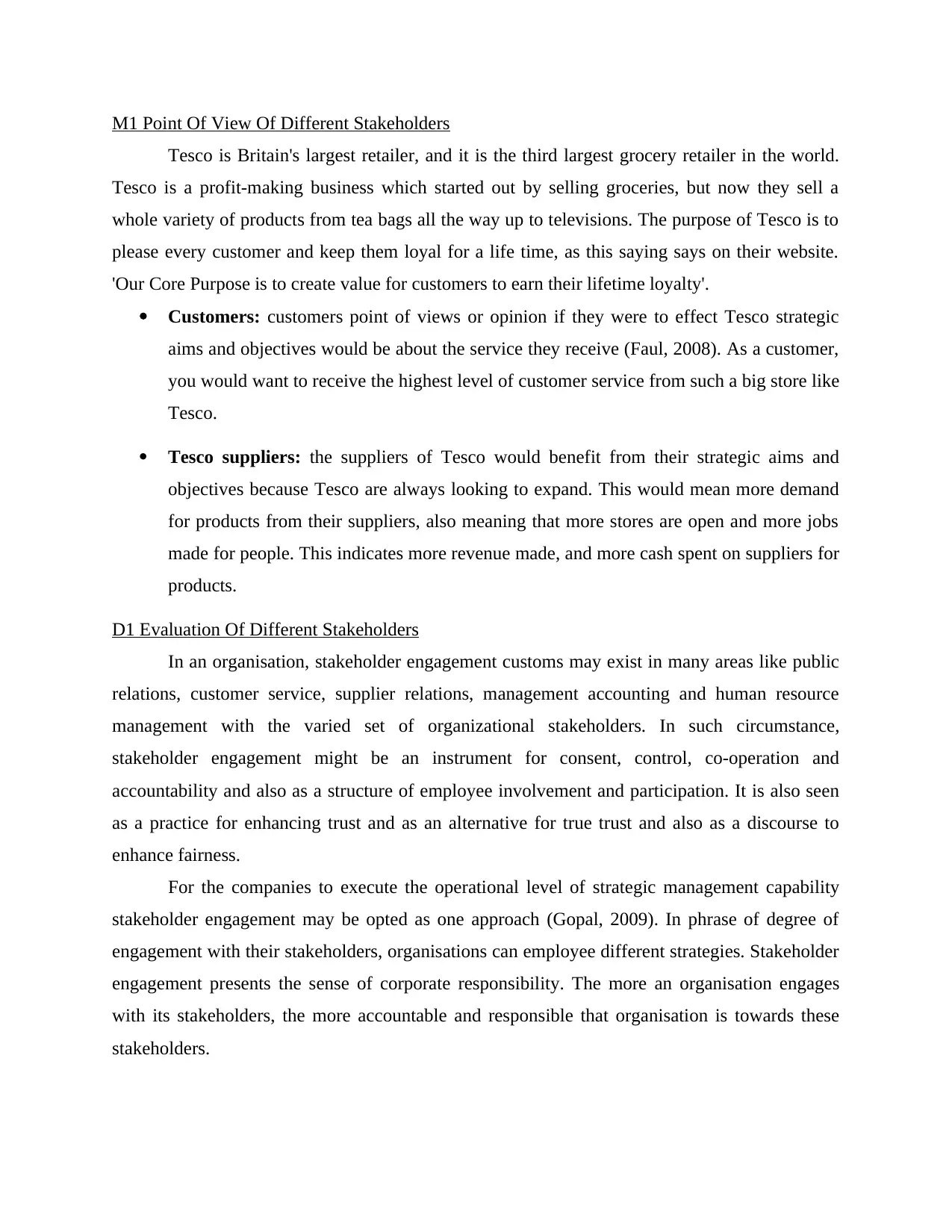
M1 Point Of View Of Different Stakeholders
Tesco is Britain's largest retailer, and it is the third largest grocery retailer in the world.
Tesco is a profit-making business which started out by selling groceries, but now they sell a
whole variety of products from tea bags all the way up to televisions. The purpose of Tesco is to
please every customer and keep them loyal for a life time, as this saying says on their website.
'Our Core Purpose is to create value for customers to earn their lifetime loyalty'.
Customers: customers point of views or opinion if they were to effect Tesco strategic
aims and objectives would be about the service they receive (Faul, 2008). As a customer,
you would want to receive the highest level of customer service from such a big store like
Tesco.
Tesco suppliers: the suppliers of Tesco would benefit from their strategic aims and
objectives because Tesco are always looking to expand. This would mean more demand
for products from their suppliers, also meaning that more stores are open and more jobs
made for people. This indicates more revenue made, and more cash spent on suppliers for
products.
D1 Evaluation Of Different Stakeholders
In an organisation, stakeholder engagement customs may exist in many areas like public
relations, customer service, supplier relations, management accounting and human resource
management with the varied set of organizational stakeholders. In such circumstance,
stakeholder engagement might be an instrument for consent, control, co-operation and
accountability and also as a structure of employee involvement and participation. It is also seen
as a practice for enhancing trust and as an alternative for true trust and also as a discourse to
enhance fairness.
For the companies to execute the operational level of strategic management capability
stakeholder engagement may be opted as one approach (Gopal, 2009). In phrase of degree of
engagement with their stakeholders, organisations can employee different strategies. Stakeholder
engagement presents the sense of corporate responsibility. The more an organisation engages
with its stakeholders, the more accountable and responsible that organisation is towards these
stakeholders.
Tesco is Britain's largest retailer, and it is the third largest grocery retailer in the world.
Tesco is a profit-making business which started out by selling groceries, but now they sell a
whole variety of products from tea bags all the way up to televisions. The purpose of Tesco is to
please every customer and keep them loyal for a life time, as this saying says on their website.
'Our Core Purpose is to create value for customers to earn their lifetime loyalty'.
Customers: customers point of views or opinion if they were to effect Tesco strategic
aims and objectives would be about the service they receive (Faul, 2008). As a customer,
you would want to receive the highest level of customer service from such a big store like
Tesco.
Tesco suppliers: the suppliers of Tesco would benefit from their strategic aims and
objectives because Tesco are always looking to expand. This would mean more demand
for products from their suppliers, also meaning that more stores are open and more jobs
made for people. This indicates more revenue made, and more cash spent on suppliers for
products.
D1 Evaluation Of Different Stakeholders
In an organisation, stakeholder engagement customs may exist in many areas like public
relations, customer service, supplier relations, management accounting and human resource
management with the varied set of organizational stakeholders. In such circumstance,
stakeholder engagement might be an instrument for consent, control, co-operation and
accountability and also as a structure of employee involvement and participation. It is also seen
as a practice for enhancing trust and as an alternative for true trust and also as a discourse to
enhance fairness.
For the companies to execute the operational level of strategic management capability
stakeholder engagement may be opted as one approach (Gopal, 2009). In phrase of degree of
engagement with their stakeholders, organisations can employee different strategies. Stakeholder
engagement presents the sense of corporate responsibility. The more an organisation engages
with its stakeholders, the more accountable and responsible that organisation is towards these
stakeholders.
⊘ This is a preview!⊘
Do you want full access?
Subscribe today to unlock all pages.

Trusted by 1+ million students worldwide
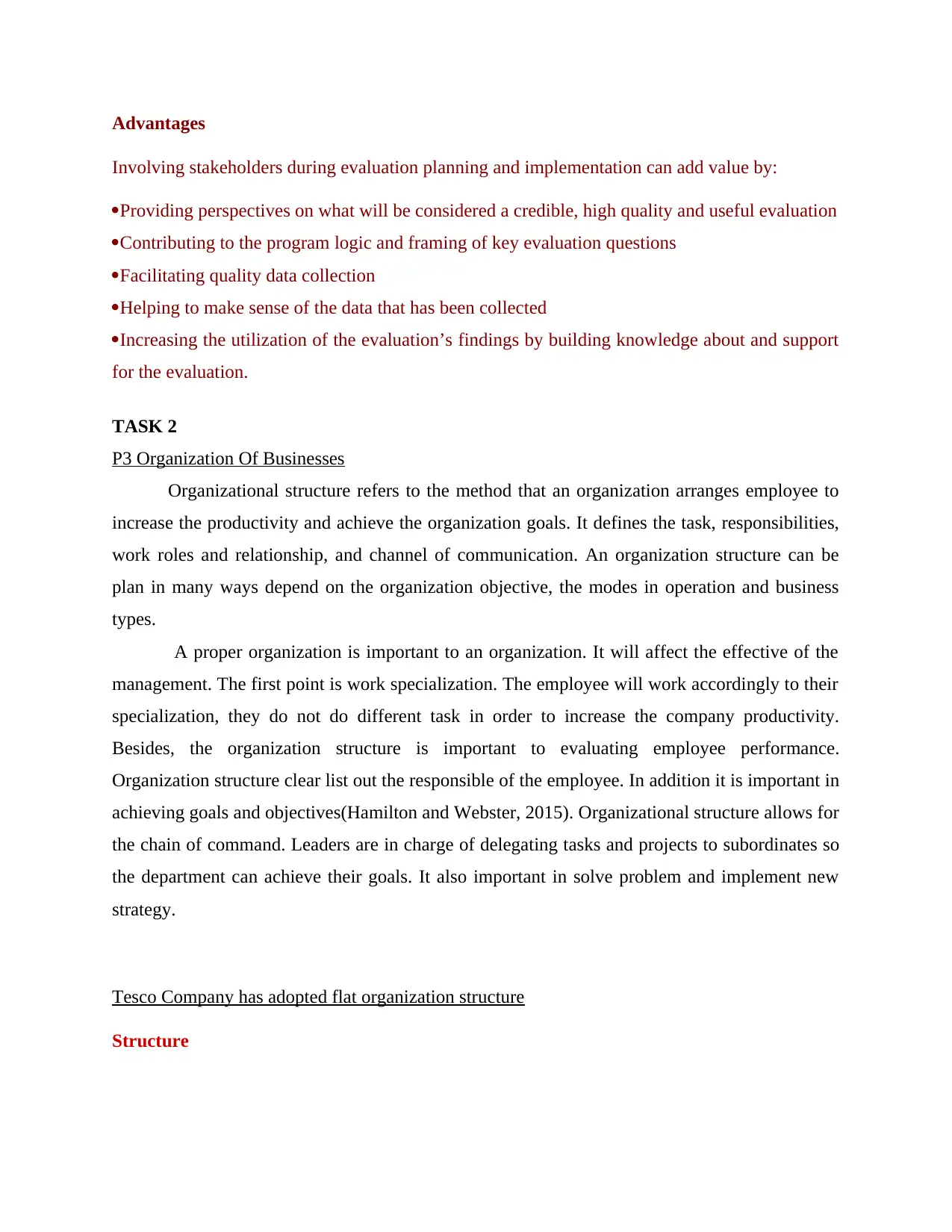
Advantages
Involving stakeholders during evaluation planning and implementation can add value by:
Providing perspectives on what will be considered a credible, high quality and useful evaluation
Contributing to the program logic and framing of key evaluation questions
Facilitating quality data collection
Helping to make sense of the data that has been collected
Increasing the utilization of the evaluation’s findings by building knowledge about and support
for the evaluation.
TASK 2
P3 Organization Of Businesses
Organizational structure refers to the method that an organization arranges employee to
increase the productivity and achieve the organization goals. It defines the task, responsibilities,
work roles and relationship, and channel of communication. An organization structure can be
plan in many ways depend on the organization objective, the modes in operation and business
types.
A proper organization is important to an organization. It will affect the effective of the
management. The first point is work specialization. The employee will work accordingly to their
specialization, they do not do different task in order to increase the company productivity.
Besides, the organization structure is important to evaluating employee performance.
Organization structure clear list out the responsible of the employee. In addition it is important in
achieving goals and objectives(Hamilton and Webster, 2015). Organizational structure allows for
the chain of command. Leaders are in charge of delegating tasks and projects to subordinates so
the department can achieve their goals. It also important in solve problem and implement new
strategy.
Tesco Company has adopted flat organization structure
Structure
Involving stakeholders during evaluation planning and implementation can add value by:
Providing perspectives on what will be considered a credible, high quality and useful evaluation
Contributing to the program logic and framing of key evaluation questions
Facilitating quality data collection
Helping to make sense of the data that has been collected
Increasing the utilization of the evaluation’s findings by building knowledge about and support
for the evaluation.
TASK 2
P3 Organization Of Businesses
Organizational structure refers to the method that an organization arranges employee to
increase the productivity and achieve the organization goals. It defines the task, responsibilities,
work roles and relationship, and channel of communication. An organization structure can be
plan in many ways depend on the organization objective, the modes in operation and business
types.
A proper organization is important to an organization. It will affect the effective of the
management. The first point is work specialization. The employee will work accordingly to their
specialization, they do not do different task in order to increase the company productivity.
Besides, the organization structure is important to evaluating employee performance.
Organization structure clear list out the responsible of the employee. In addition it is important in
achieving goals and objectives(Hamilton and Webster, 2015). Organizational structure allows for
the chain of command. Leaders are in charge of delegating tasks and projects to subordinates so
the department can achieve their goals. It also important in solve problem and implement new
strategy.
Tesco Company has adopted flat organization structure
Structure
Paraphrase This Document
Need a fresh take? Get an instant paraphrase of this document with our AI Paraphraser
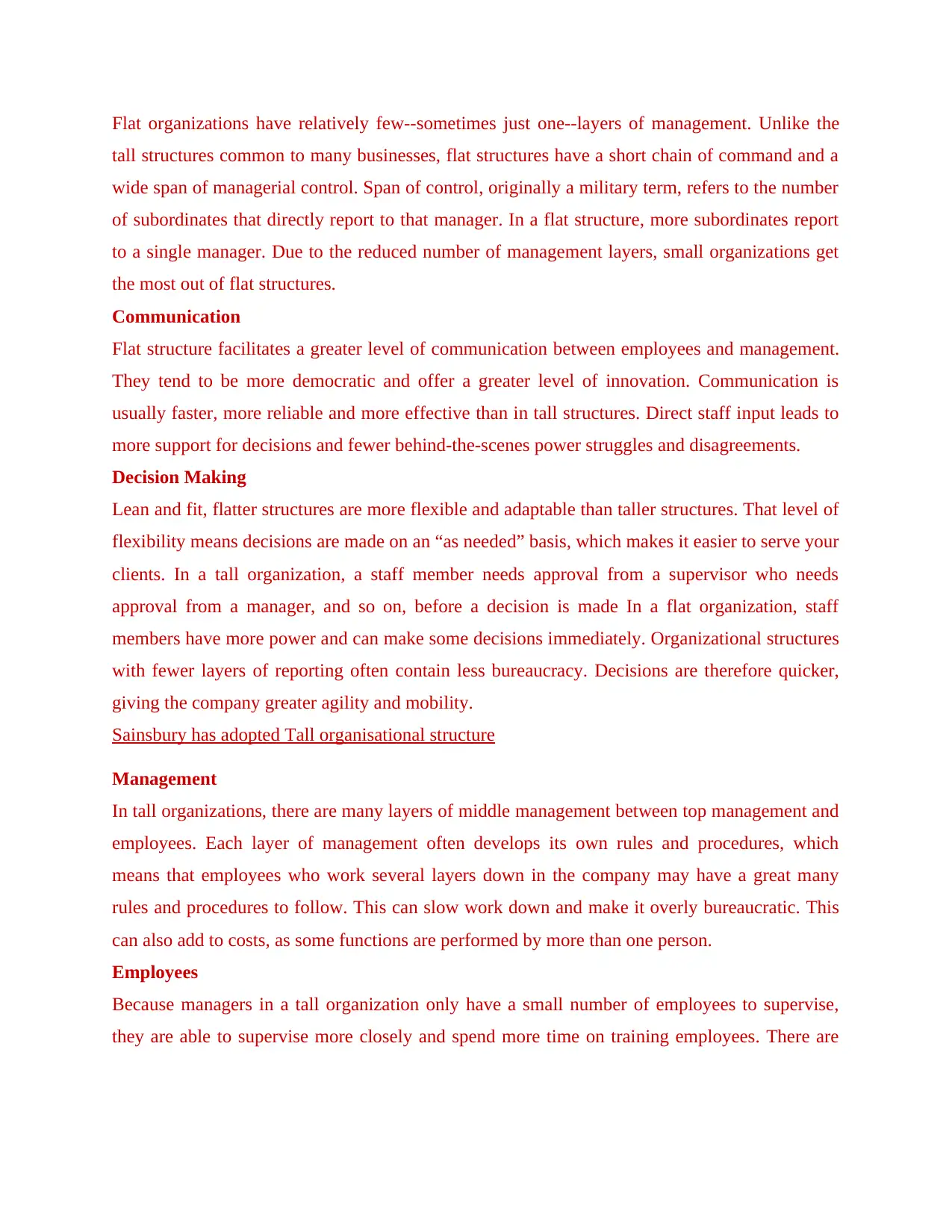
Flat organizations have relatively few--sometimes just one--layers of management. Unlike the
tall structures common to many businesses, flat structures have a short chain of command and a
wide span of managerial control. Span of control, originally a military term, refers to the number
of subordinates that directly report to that manager. In a flat structure, more subordinates report
to a single manager. Due to the reduced number of management layers, small organizations get
the most out of flat structures.
Communication
Flat structure facilitates a greater level of communication between employees and management.
They tend to be more democratic and offer a greater level of innovation. Communication is
usually faster, more reliable and more effective than in tall structures. Direct staff input leads to
more support for decisions and fewer behind-the-scenes power struggles and disagreements.
Decision Making
Lean and fit, flatter structures are more flexible and adaptable than taller structures. That level of
flexibility means decisions are made on an “as needed” basis, which makes it easier to serve your
clients. In a tall organization, a staff member needs approval from a supervisor who needs
approval from a manager, and so on, before a decision is made In a flat organization, staff
members have more power and can make some decisions immediately. Organizational structures
with fewer layers of reporting often contain less bureaucracy. Decisions are therefore quicker,
giving the company greater agility and mobility.
Sainsbury has adopted Tall organisational structure
Management
In tall organizations, there are many layers of middle management between top management and
employees. Each layer of management often develops its own rules and procedures, which
means that employees who work several layers down in the company may have a great many
rules and procedures to follow. This can slow work down and make it overly bureaucratic. This
can also add to costs, as some functions are performed by more than one person.
Employees
Because managers in a tall organization only have a small number of employees to supervise,
they are able to supervise more closely and spend more time on training employees. There are
tall structures common to many businesses, flat structures have a short chain of command and a
wide span of managerial control. Span of control, originally a military term, refers to the number
of subordinates that directly report to that manager. In a flat structure, more subordinates report
to a single manager. Due to the reduced number of management layers, small organizations get
the most out of flat structures.
Communication
Flat structure facilitates a greater level of communication between employees and management.
They tend to be more democratic and offer a greater level of innovation. Communication is
usually faster, more reliable and more effective than in tall structures. Direct staff input leads to
more support for decisions and fewer behind-the-scenes power struggles and disagreements.
Decision Making
Lean and fit, flatter structures are more flexible and adaptable than taller structures. That level of
flexibility means decisions are made on an “as needed” basis, which makes it easier to serve your
clients. In a tall organization, a staff member needs approval from a supervisor who needs
approval from a manager, and so on, before a decision is made In a flat organization, staff
members have more power and can make some decisions immediately. Organizational structures
with fewer layers of reporting often contain less bureaucracy. Decisions are therefore quicker,
giving the company greater agility and mobility.
Sainsbury has adopted Tall organisational structure
Management
In tall organizations, there are many layers of middle management between top management and
employees. Each layer of management often develops its own rules and procedures, which
means that employees who work several layers down in the company may have a great many
rules and procedures to follow. This can slow work down and make it overly bureaucratic. This
can also add to costs, as some functions are performed by more than one person.
Employees
Because managers in a tall organization only have a small number of employees to supervise,
they are able to supervise more closely and spend more time on training employees. There are
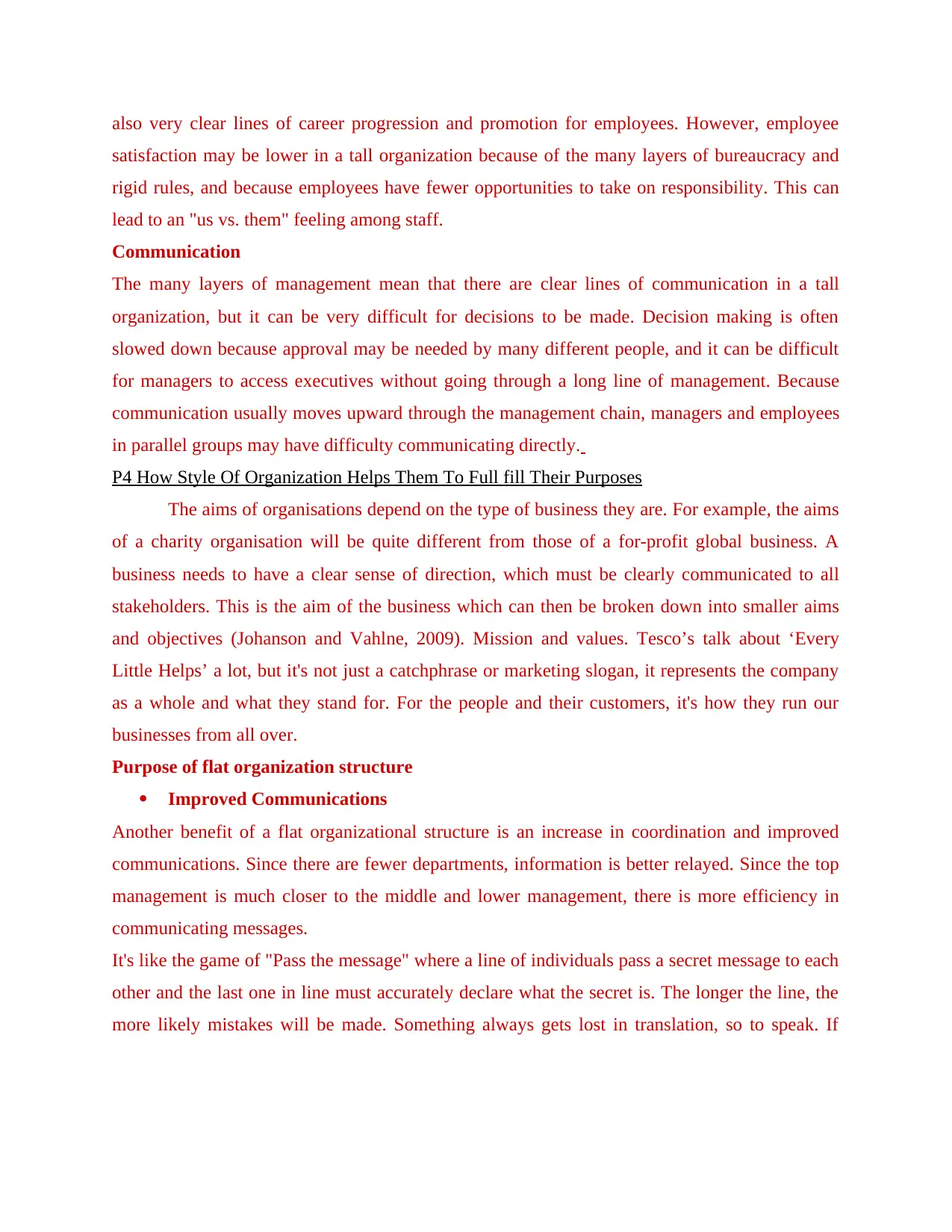
also very clear lines of career progression and promotion for employees. However, employee
satisfaction may be lower in a tall organization because of the many layers of bureaucracy and
rigid rules, and because employees have fewer opportunities to take on responsibility. This can
lead to an "us vs. them" feeling among staff.
Communication
The many layers of management mean that there are clear lines of communication in a tall
organization, but it can be very difficult for decisions to be made. Decision making is often
slowed down because approval may be needed by many different people, and it can be difficult
for managers to access executives without going through a long line of management. Because
communication usually moves upward through the management chain, managers and employees
in parallel groups may have difficulty communicating directly.
P4 How Style Of Organization Helps Them To Full fill Their Purposes
The aims of organisations depend on the type of business they are. For example, the aims
of a charity organisation will be quite different from those of a for-profit global business. A
business needs to have a clear sense of direction, which must be clearly communicated to all
stakeholders. This is the aim of the business which can then be broken down into smaller aims
and objectives (Johanson and Vahlne, 2009). Mission and values. Tesco’s talk about ‘Every
Little Helps’ a lot, but it's not just a catchphrase or marketing slogan, it represents the company
as a whole and what they stand for. For the people and their customers, it's how they run our
businesses from all over.
Purpose of flat organization structure
Improved Communications
Another benefit of a flat organizational structure is an increase in coordination and improved
communications. Since there are fewer departments, information is better relayed. Since the top
management is much closer to the middle and lower management, there is more efficiency in
communicating messages.
It's like the game of "Pass the message" where a line of individuals pass a secret message to each
other and the last one in line must accurately declare what the secret is. The longer the line, the
more likely mistakes will be made. Something always gets lost in translation, so to speak. If
satisfaction may be lower in a tall organization because of the many layers of bureaucracy and
rigid rules, and because employees have fewer opportunities to take on responsibility. This can
lead to an "us vs. them" feeling among staff.
Communication
The many layers of management mean that there are clear lines of communication in a tall
organization, but it can be very difficult for decisions to be made. Decision making is often
slowed down because approval may be needed by many different people, and it can be difficult
for managers to access executives without going through a long line of management. Because
communication usually moves upward through the management chain, managers and employees
in parallel groups may have difficulty communicating directly.
P4 How Style Of Organization Helps Them To Full fill Their Purposes
The aims of organisations depend on the type of business they are. For example, the aims
of a charity organisation will be quite different from those of a for-profit global business. A
business needs to have a clear sense of direction, which must be clearly communicated to all
stakeholders. This is the aim of the business which can then be broken down into smaller aims
and objectives (Johanson and Vahlne, 2009). Mission and values. Tesco’s talk about ‘Every
Little Helps’ a lot, but it's not just a catchphrase or marketing slogan, it represents the company
as a whole and what they stand for. For the people and their customers, it's how they run our
businesses from all over.
Purpose of flat organization structure
Improved Communications
Another benefit of a flat organizational structure is an increase in coordination and improved
communications. Since there are fewer departments, information is better relayed. Since the top
management is much closer to the middle and lower management, there is more efficiency in
communicating messages.
It's like the game of "Pass the message" where a line of individuals pass a secret message to each
other and the last one in line must accurately declare what the secret is. The longer the line, the
more likely mistakes will be made. Something always gets lost in translation, so to speak. If
⊘ This is a preview!⊘
Do you want full access?
Subscribe today to unlock all pages.

Trusted by 1+ million students worldwide
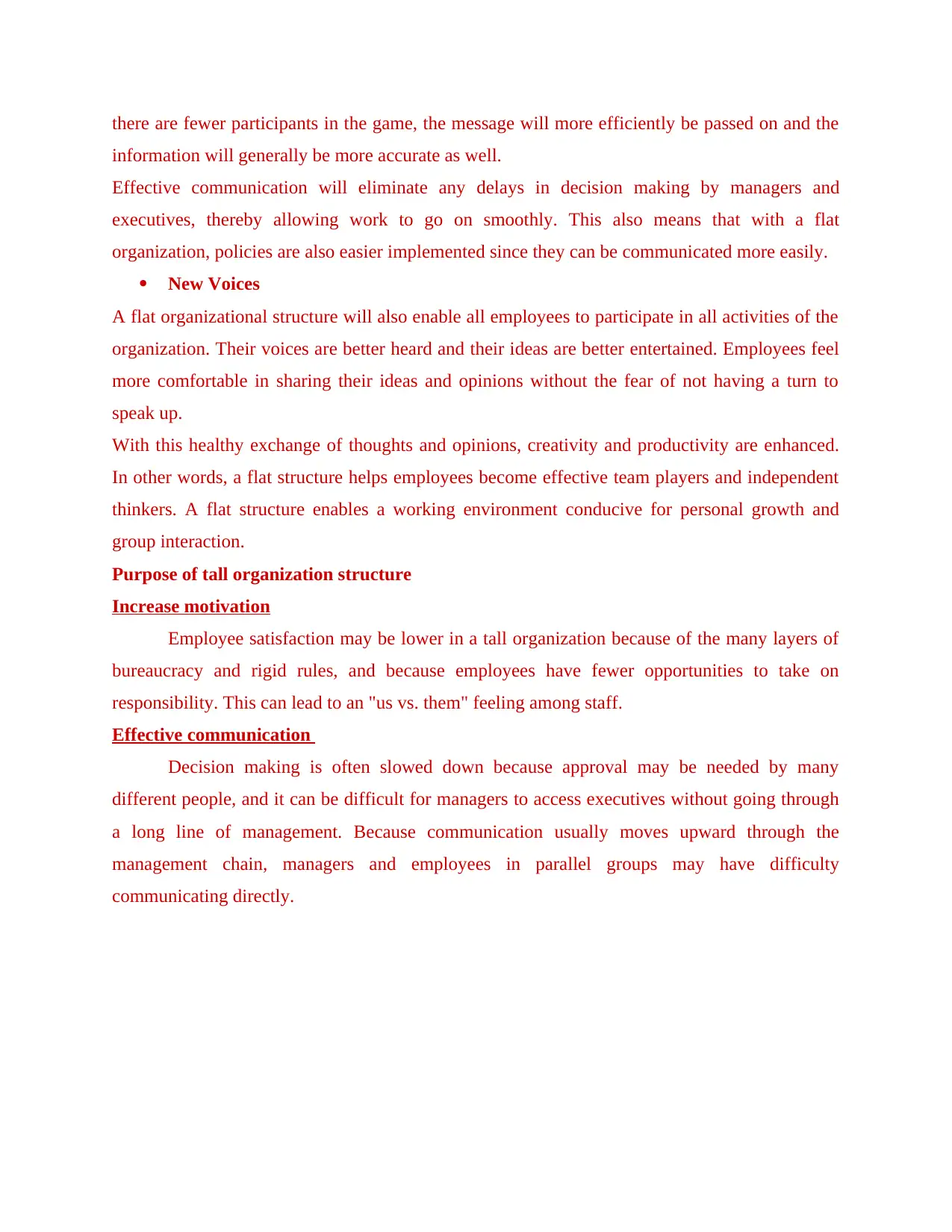
there are fewer participants in the game, the message will more efficiently be passed on and the
information will generally be more accurate as well.
Effective communication will eliminate any delays in decision making by managers and
executives, thereby allowing work to go on smoothly. This also means that with a flat
organization, policies are also easier implemented since they can be communicated more easily.
New Voices
A flat organizational structure will also enable all employees to participate in all activities of the
organization. Their voices are better heard and their ideas are better entertained. Employees feel
more comfortable in sharing their ideas and opinions without the fear of not having a turn to
speak up.
With this healthy exchange of thoughts and opinions, creativity and productivity are enhanced.
In other words, a flat structure helps employees become effective team players and independent
thinkers. A flat structure enables a working environment conducive for personal growth and
group interaction.
Purpose of tall organization structure
Increase motivation
Employee satisfaction may be lower in a tall organization because of the many layers of
bureaucracy and rigid rules, and because employees have fewer opportunities to take on
responsibility. This can lead to an "us vs. them" feeling among staff.
Effective communication
Decision making is often slowed down because approval may be needed by many
different people, and it can be difficult for managers to access executives without going through
a long line of management. Because communication usually moves upward through the
management chain, managers and employees in parallel groups may have difficulty
communicating directly.
information will generally be more accurate as well.
Effective communication will eliminate any delays in decision making by managers and
executives, thereby allowing work to go on smoothly. This also means that with a flat
organization, policies are also easier implemented since they can be communicated more easily.
New Voices
A flat organizational structure will also enable all employees to participate in all activities of the
organization. Their voices are better heard and their ideas are better entertained. Employees feel
more comfortable in sharing their ideas and opinions without the fear of not having a turn to
speak up.
With this healthy exchange of thoughts and opinions, creativity and productivity are enhanced.
In other words, a flat structure helps employees become effective team players and independent
thinkers. A flat structure enables a working environment conducive for personal growth and
group interaction.
Purpose of tall organization structure
Increase motivation
Employee satisfaction may be lower in a tall organization because of the many layers of
bureaucracy and rigid rules, and because employees have fewer opportunities to take on
responsibility. This can lead to an "us vs. them" feeling among staff.
Effective communication
Decision making is often slowed down because approval may be needed by many
different people, and it can be difficult for managers to access executives without going through
a long line of management. Because communication usually moves upward through the
management chain, managers and employees in parallel groups may have difficulty
communicating directly.
Paraphrase This Document
Need a fresh take? Get an instant paraphrase of this document with our AI Paraphraser

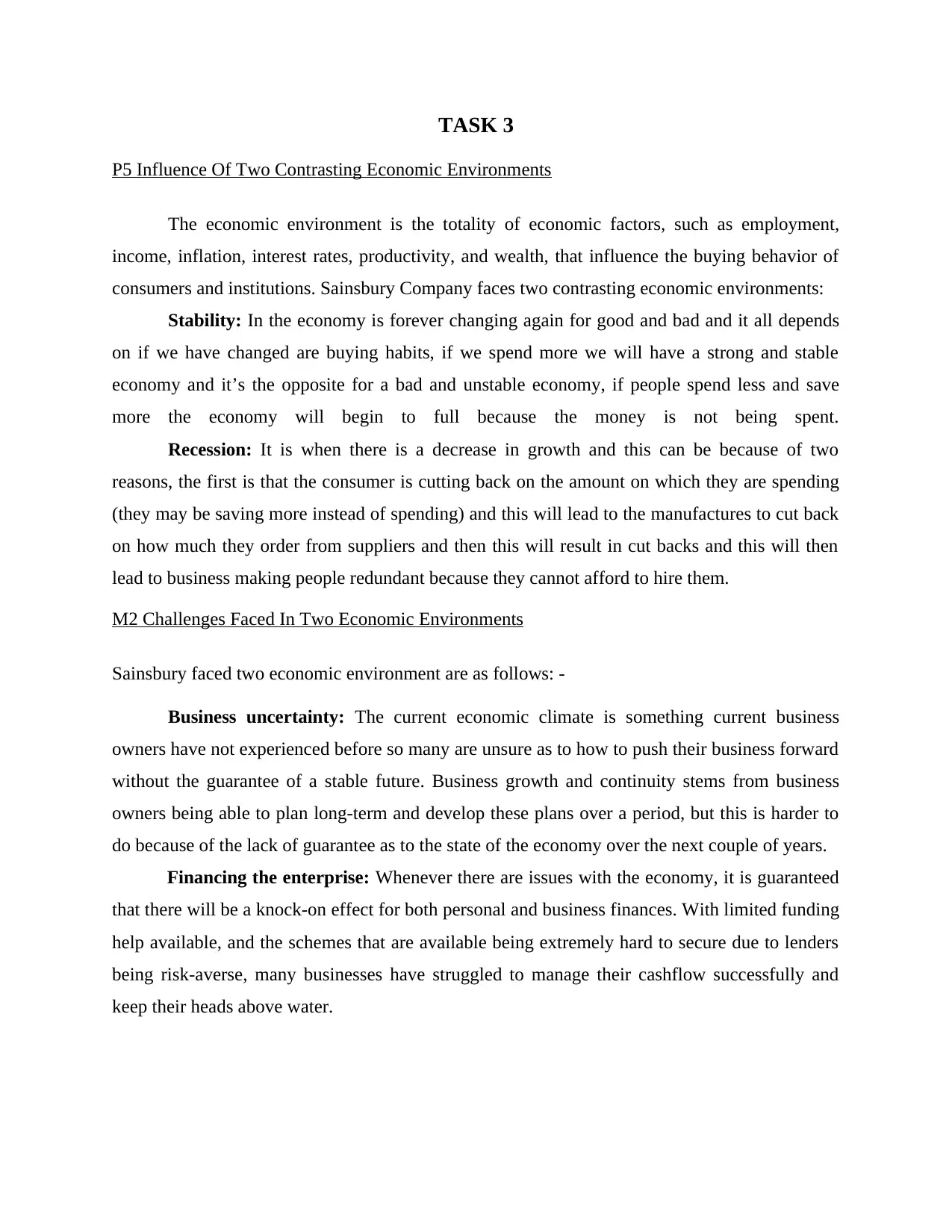
TASK 3
P5 Influence Of Two Contrasting Economic Environments
The economic environment is the totality of economic factors, such as employment,
income, inflation, interest rates, productivity, and wealth, that influence the buying behavior of
consumers and institutions. Sainsbury Company faces two contrasting economic environments:
Stability: In the economy is forever changing again for good and bad and it all depends
on if we have changed are buying habits, if we spend more we will have a strong and stable
economy and it’s the opposite for a bad and unstable economy, if people spend less and save
more the economy will begin to full because the money is not being spent.
Recession: It is when there is a decrease in growth and this can be because of two
reasons, the first is that the consumer is cutting back on the amount on which they are spending
(they may be saving more instead of spending) and this will lead to the manufactures to cut back
on how much they order from suppliers and then this will result in cut backs and this will then
lead to business making people redundant because they cannot afford to hire them.
M2 Challenges Faced In Two Economic Environments
Sainsbury faced two economic environment are as follows: -
Business uncertainty: The current economic climate is something current business
owners have not experienced before so many are unsure as to how to push their business forward
without the guarantee of a stable future. Business growth and continuity stems from business
owners being able to plan long-term and develop these plans over a period, but this is harder to
do because of the lack of guarantee as to the state of the economy over the next couple of years.
Financing the enterprise: Whenever there are issues with the economy, it is guaranteed
that there will be a knock-on effect for both personal and business finances. With limited funding
help available, and the schemes that are available being extremely hard to secure due to lenders
being risk-averse, many businesses have struggled to manage their cashflow successfully and
keep their heads above water.
P5 Influence Of Two Contrasting Economic Environments
The economic environment is the totality of economic factors, such as employment,
income, inflation, interest rates, productivity, and wealth, that influence the buying behavior of
consumers and institutions. Sainsbury Company faces two contrasting economic environments:
Stability: In the economy is forever changing again for good and bad and it all depends
on if we have changed are buying habits, if we spend more we will have a strong and stable
economy and it’s the opposite for a bad and unstable economy, if people spend less and save
more the economy will begin to full because the money is not being spent.
Recession: It is when there is a decrease in growth and this can be because of two
reasons, the first is that the consumer is cutting back on the amount on which they are spending
(they may be saving more instead of spending) and this will lead to the manufactures to cut back
on how much they order from suppliers and then this will result in cut backs and this will then
lead to business making people redundant because they cannot afford to hire them.
M2 Challenges Faced In Two Economic Environments
Sainsbury faced two economic environment are as follows: -
Business uncertainty: The current economic climate is something current business
owners have not experienced before so many are unsure as to how to push their business forward
without the guarantee of a stable future. Business growth and continuity stems from business
owners being able to plan long-term and develop these plans over a period, but this is harder to
do because of the lack of guarantee as to the state of the economy over the next couple of years.
Financing the enterprise: Whenever there are issues with the economy, it is guaranteed
that there will be a knock-on effect for both personal and business finances. With limited funding
help available, and the schemes that are available being extremely hard to secure due to lenders
being risk-averse, many businesses have struggled to manage their cashflow successfully and
keep their heads above water.
⊘ This is a preview!⊘
Do you want full access?
Subscribe today to unlock all pages.

Trusted by 1+ million students worldwide
1 out of 16
Related Documents
Your All-in-One AI-Powered Toolkit for Academic Success.
+13062052269
info@desklib.com
Available 24*7 on WhatsApp / Email
![[object Object]](/_next/static/media/star-bottom.7253800d.svg)
Unlock your academic potential
Copyright © 2020–2025 A2Z Services. All Rights Reserved. Developed and managed by ZUCOL.




